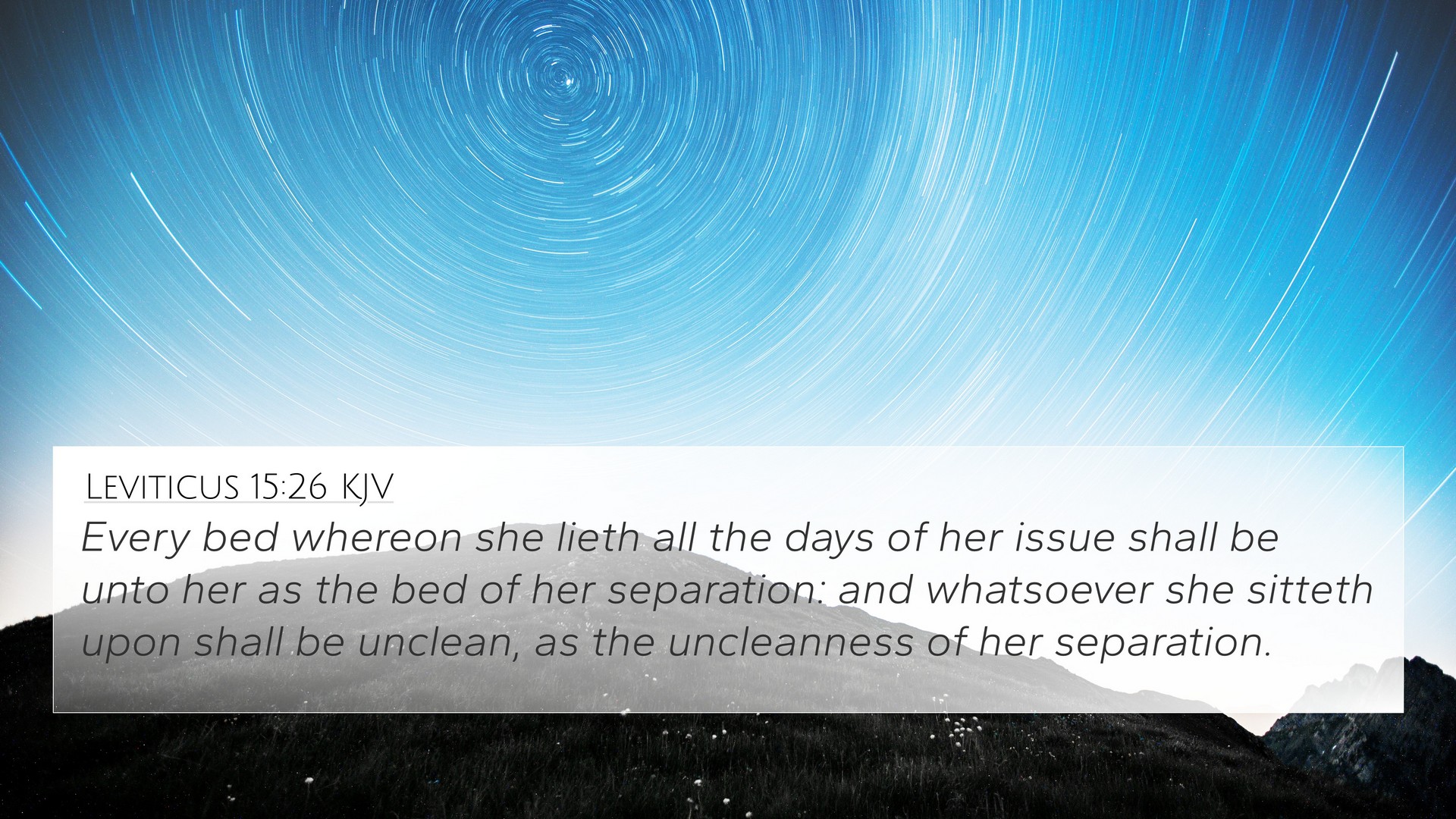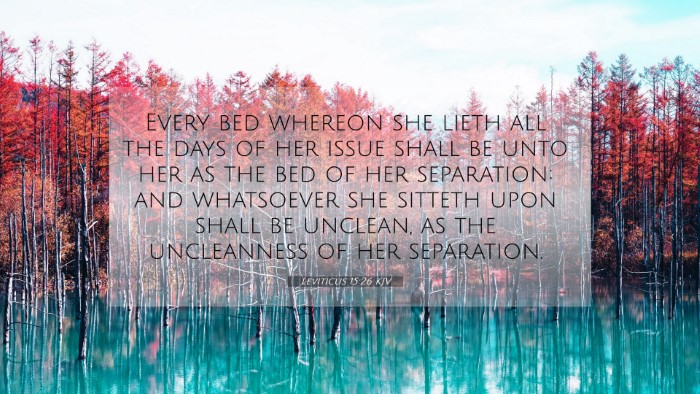Understanding Leviticus 15:26
Bible Verse: Leviticus 15:26 states, "Every bed on which she lies all the days of her issue shall be to her as the bed of her separation; and whatever she sits on shall be unclean, as the uncleanness of her impurity."
Overview: This verse is part of the purity laws given to the Israelites regarding bodily discharges, specifically a woman's menstrual cycle. It emphasizes the concept of ritual cleanliness and how certain physical conditions can affect a person's status in the community.
Commentary Insights
This verse has been analyzed in different commentaries, revealing various dimensions of its meaning:
- Matthew Henry's Commentary: Henry emphasizes the physical and spiritual implications of impurity, explaining that the laws highlight the seriousness of maintaining cleanliness. He suggests that these laws served to remind the Israelites of their covenant with God, emphasizing the need for holiness in all aspects of life.
- Albert Barnes' Notes: Barnes interprets the bed and sitting places as symbols of broader spiritual and communal purity. He notes that the emphasis is on the separateness of those deemed unclean and the need for a process of restoration. He draws connections to Christ's teachings on purity and ritual understanding in the New Testament.
- Adam Clarke's Commentary: Clarke offers a view that these laws were practical and meant to foster a culture of respect and consideration among community members. He discusses the implications for women and societal norms of the time, highlighting the importance of understanding these cultural contexts when interpreting Biblical texts.
Thematic Connections
Within the Bible, Leviticus 15:26 connects with several other verses that also discuss themes of purity, uncleanness, and community standards.
- Numbers 19:22: Discusses what makes a person unclean and the implications for community participation.
- Isaiah 64:6: Reflects on the idea that all our righteousness is like filthy rags, underlining the need for spiritual cleanliness.
- Mark 5:25-34: The story of the woman with the issue of blood connects New Testament understanding of physical purity with spiritual healing through faith in Jesus.
- Hebrews 9:13-14: Talks about the blood of sacrifices purifying the flesh, which can be seen as a foreshadowing of Christ's ultimate sacrifice.
- 1 Peter 1:15-16: Calls believers to be holy as God is holy, linking back to the purity laws of the Old Testament.
- Matthew 9:20-22: Similar to Mark, it recounts the story of a healing that connects physical acts of impurity with spiritual restoration.
- James 4:8: Addresses the call to purify our hearts, relating closely to the themes of Levitical law regarding physical purity and moral integrity.
Cross-Referencing Biblical Texts
To fully understand Leviticus 15:26, it's essential to explore related Biblical texts. These connections manifest the overarching themes of purity, community, and God’s standards across both Testaments. This encourages deeper comparative Bible verse analysis and helps in identifying connections between Old and New Testaments.
Tools for Bible Cross-Referencing
When studying this verse, consider utilizing various tools for effective cross-referencing:
- Bible Concordance: Provides an alphabetical listing of words and passages to help find specific verses.
- Bible Cross-Reference Guide: Lists verses related to specific themes or stories for easier navigation.
- Bible Chain References: Offers a system of linked verses for thematic study.
- Cross-reference Bible Study Methods: Helps in the comparative study of verses to understand Biblical unity and diversity.
- Comprehensive Bible Cross-Reference Materials: Various resources that compile significant cross-references for deeper study.
User Intent
When exploring Leviticus 15:26, users often seek to:
- Find cross-references for the verse to uncover its relationship with other scriptures.
- Understand how it connects to New Testament teachings on purity and holiness.
- Explore similarities between this verse and those that address the physical and spiritual implications of uncleanness.
Conclusion
The study of Leviticus 15:26 provides rich insights into the laws of ritual purity that governed ancient Israelite life. By cross-referencing with other scripture, we gain a better understanding of God's call to holiness, the significance of communal practices, and the broader implications seen in the New Testament. This engagement with the text enables believers to see the connections not only within the scripture but also how these ancient laws reflect the heart of God towards His people.


